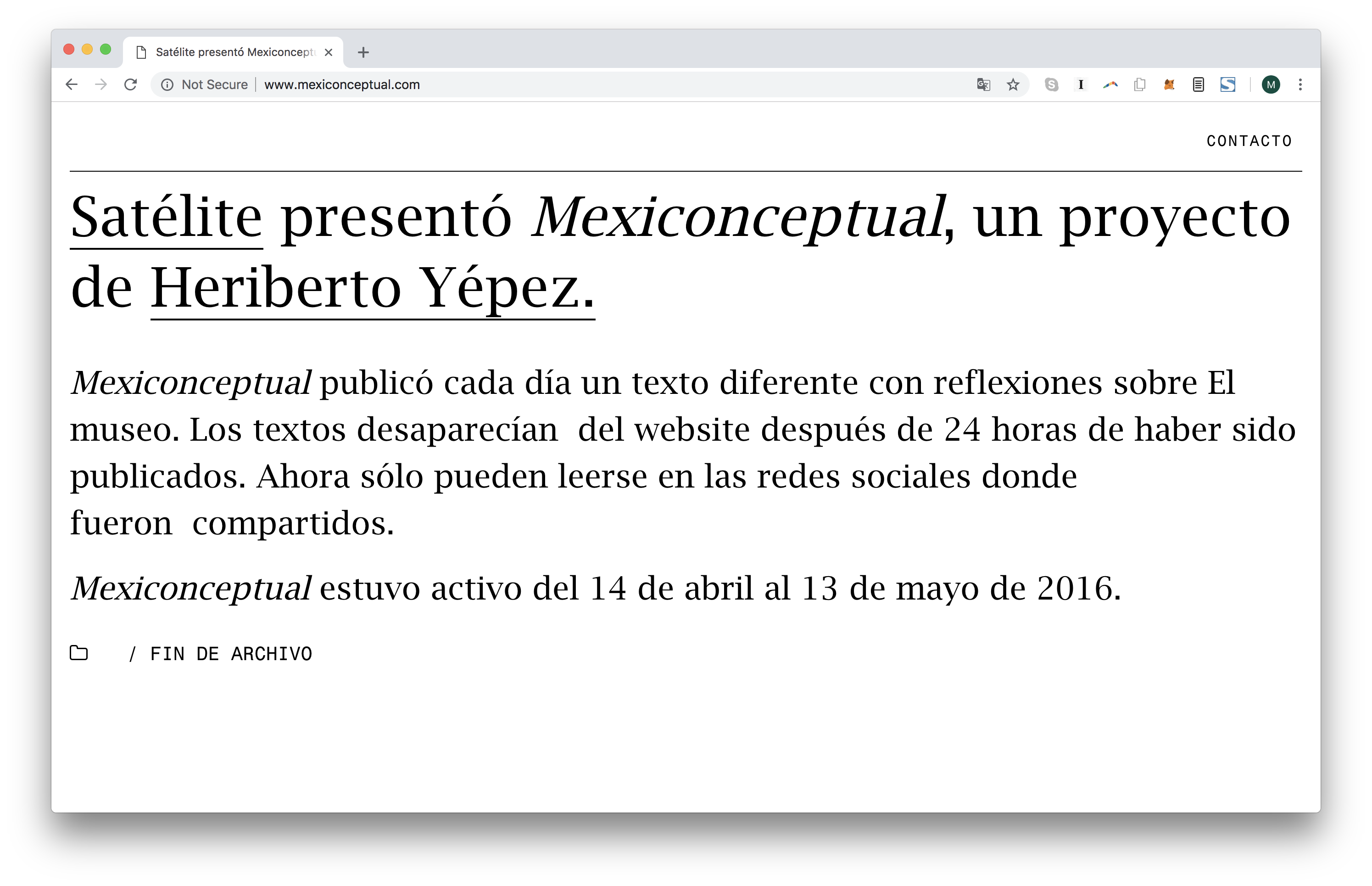Heriberto Yépez (Satélite), Mexiconceptual , 2016. Social media performance and website. Screenshot, 2018, Google Chrome 69 on macOS 10.14, www.mexiconceptual.com.
This article accompanies the inclusion of Mexiconceptual (2016) by Heriberto Yépez (Satélite) in the online exhibition Net Art Anthology. It was originally published as “Entrevista | Heriberto Yépez,” GASTV, May 2016, and has been translated from Spanish.
VIOLETA HORCASITAS: Through my curatorial initiative Satélite, I use collaboration with artists to generate projects. Dialogical commissions of this kind have very satisfactory implications from a curatorial perspective, such as being able to discuss the interests of each artist and have a much clearer idea of the piece in general. On the other hand, it is a complicated process, in which the project management also becomes part of the curatorial scope.
From your standpoint, I would like to know what it meant/added/subtracted, both in terms of narrative and format, to be assigned a commission on the theme of the museum.
HERIBERTO YÉPEZ: I enjoyed it perversely, due to the constriction. In a sense, it is not a totally foreign experience to me, because I constantly work on topics chosen by others, for example, in my academic work I receive an invitation to a conference on a certain topic and prepare a paper that responds to the specific thematic invitation, already decided. In another sense, because it is an artistic commission on the theme of museum, my usual frame of writing was moved; you forced me to do something different and, then, we decided that the work would revolve around this triad: Museum, Mexico, Conceptualism. From these three word-signs came the sub-themes of each text and the general form of the work.
VH: I know that your practice develops from poetry and literature, and not from contemporary art per se. When I invited you, I was interested in hearing the perception of other agents outside the limited circuit called “contemporary art.” Can you reflect on the different positions and approaches that can be given from other practices on the museum? What did this exercise mean for a different audience in that sense?
HY: I think that many readers and internet users perceive me as a literary writer, because most of what I publish goes in that direction. But I have worked as a professor of aesthetics and art theory for more than a decade. In those years, literature was my work at night, so to speak, but my day job was the theory of art, from which came, for example, my research project and co-edition of Ulises Carrión and others that are unpublished. On the other hand, my origins as a writer were within the border art movement; I was one of the critics-participants on site of the contemporary art scene in Tijuana. Many of my friends, in fact, have rather been electronic musicians and visual artists; the cultural scene of Tijuana at that time was very mixed, there was no literary scene isolated from the artistic one.
What I want to say is that in my daily life I work more as a writer in the context of US-MX border contemporary art, experimental American poetics, and the internet. With the literary world, practically, I have no major daily contact. Something that I liked about this project was that, precisely, I was able to develop on the internet in Mexico what I do every day on the border and the United States.
VH: Another interest in my work is the exploration and implementation of new exhibition formats. Almost all the curatorial projects I have done participate in such efforts, as in the case of artists whose work comes from the physical-sculptural terrain but have done a virtual project for Satélite, in a postinternet environment. I would like to know if Satélite somehow led to a rethinking in some way of your idea of the museum, and what is your perception about this platform in general.
HY: When you invited me and I got to know the Satélite project and the works that had already been done, I liked that profile of experimentation with other formats, conditions, and spaces. The museum, as a physical space, as a white cube, is not exhausted, but it does not stand on its own anymore. You have to mobilize what happens there, or make something happen, something different. I like the idea of Satélite as something that has its own life, a lunar structure, for example, at the same time that it requires a strained relationship with another structure, in this case, the museum. That concept, in the sense of a regime of existence, seems to me to immediately allude to the very concept of art at this time. Mexiconceptual emerged from this tension.
VH: At some point you commented that this project would resignify Experimentalism in Mexico. Could you go expand on this?
HY: It’s my counter-history proposal. If we drew all the figures or scenes that I approached, the image woul be of a wide, hypertrophic mural, a great collage. I gathered, for example, the current experimentalism in writing with the experimentalism of the visual arts in Mexico, and that had not been done; I mixed conceptual and post-conceptual scenes from two sides of the border and different eras. I think it was a rereading, a new cartography of the experimental in Mexico. With this assembly I believe that I managed to rethink the archive of the experimental in the arts and writings in Nafta del Sur, to disturb it, to show that it has been distorted, co-opted, expropriated; that is, institutionalized, recentralized, stripped, neocolonized.


